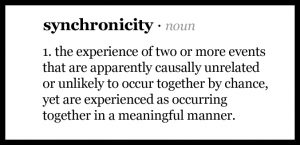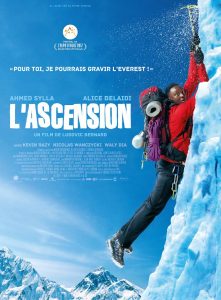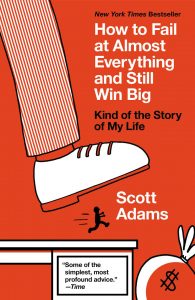
Synchronicities are purple. They creatively connect us with universal energies, myths, and themes our audience can also sense. They are messages to listen to and expand. They add magic to our lives and stories.
So far this year three interesting occasions of synchronicity have caught my attention. First Sara Safari, the speaker I am coaching for One Life, an English TEDx in Paris, sent me her first draft about her amazing story of why she attempted to climb Mount Everest on the same day I saw the promotion for a new French comedy film about climbing the same mountain. Coincidence? Or a positive sign that people across the world are ready to identify with your story as they have this subject in mind. Sara’s wonderful story is not going to compete with the comedy. Yet, the fact that both arrived at the same time in my life shows that I need to be aware that powerful stories have counterparts that exist in other minds, hearts, and souls. Carl Jung called these stories archetypes. The best storytellers know archetypes resonate powerfully and build space for them into their game plan.


Both the above images connect to an archetype which I call “The Climb”. I will discuss this in a future post as “The Climb” is the underlying structure of most stories.
The second example comes from my own speaking experience. I gave my first speech of the year in praise of Julia Cameron, the author of The Artist’s Way. My speech goal was to inspire others at the start of 2017 to embrace what they rejected or avoided. I told how I had scorned The Artist’s Way as simply another bestseller in spite of several recommendations to read it. One recommendation came from Scott Dikkers during a comedy writing workshop I attended in San Francisco as part of the FunnyBizz conference. My skepticism towards The Artist’s Way finally disappeared when I found the book in a box of abandoned books which I spotted on a sidewalk a few blocks from my vacation rental. As it was my last night as a visitor in San Francisco, I recognized this as an act of synchronicity and a gift from that creative city. As many of the ideas for this blog and my Speak-The-Rainbow workshop have flourished thanks to my reading of The Artist’s Way, it was easy to inspire my audience to challenge prejudices and embrace events filled with synchonicity.
After my speech, an audience member left me a written comment about how she had read The Artist’s Way many years ago and had restarted it on January 1st 2017. The word synchronicity was written on the paper she gave me. When we tell rainbow stories, they resonate more than we anticipate and come back to us in ripples or waves. That is the proof we are connecting.

My third example comes from reading Scott Adams‘ How to Fail at Almost Everything and Still Win Big. I purchased this book with little idea it would connect so well with this blog. For a start, Scott Adams puts public speaking on his list of 13 essential things for success. Who knew? And the book has one of the most excellent descriptions of stepping on stage to give a talk I have ever read. It’s only two pages long, but well worth the investment if you wish to discover the mindset of a seasoned speaker who knows he will connect. But the strangest discovery for me was hidden in Scott Adams’ story of how his speaking career started. His first gig came when he was asked to speak for the Association of Petroleum Engineers in Calgary, Canada – my hometown. My jaw dropped when I realized that my father had been President of that association. Small world; Big connection.
When you set out to speak, write, or perfom any story in public, you must believe that such synchronicities are optimistically and realistically possible. We write and tell stories not to be unique, but to connect. Hearing afterwards that audience members were thinking the same idea, doing the same thing, or that a family member, like a father or cousin, was somehow involved in the same event, is the hidden synchonicity that make our stories richer and deeper. When that happens, we know that we have connected with our audience.